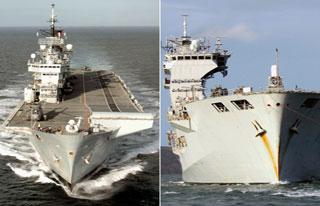
Indian Defence Minister A K Antony. A file photo
NEW DELHI (PTI): Defence Minister A K Antony Wednesday said India's armed forces modernisation was "often misconstrued" by some nations and asserted that the country had a proven track record of harnessing military technology for "peaceful and non-violent" purposes.
"Our efforts at strengthening our Armed Forces are often misconstrued by some nations. India has a proven track record of harnessing technology for peaceful and non-violent purposes and ones essentially aimed to strengthen our defence capabilities," he said without naming Pakistan or China as countries that may have those apprehensions.
"Translated in the context of aerospace industry, it would mean enhancing military and dual-use technology that would benefit our armed forces and also have spin-off benefits for the civil populace," he said delivering a lecture at an international aerospace seminar here.
He said armed forces modernisation remained on the top of the government's priority list. "However, despite our best intentions and earmarking huge budgets and allocating money, the modernisation efforts have not borne the desired results," he said.
Several procurement plans of the armed forces have been lagging behind, which included the Army's artillery modernisation, Navy's augmenting of its fast-depleting submarine fleet and the IAF's air defence capabilities and MiG-series fighter aircraft that have reached the obsolescence stage.
However, the armed forces are in the process of procuring artillery guns, medium multi-role fighter aircraft and new submarines for the forces and it is estimated that the procurement plans over the next 10 years is worth USD 100 billion.
Antony said the Defence Ministry should "continuously reduce and even eliminate procedural delays and bottlenecks" in its procurement procedures.
"It is with this realisation that we have put in place a Defence Procurement Procedure that is amended every year to speed up procurement and bring in fairness and transparency to the system," he said.
On the issue of offsets, the Defence Minister said while India "is willing to learn" from international experience, the debates on the subject provided an opportunity to the ministry officials to remove some undesired and needless misgivings on the matter.
"Our nation has been recording an impressive economic growth. However, this steadily growing potential has also meant shouldering bigger responsibilities in the strategic context. The emerging strategic landscape the world over will require a further strengthening of aerospace capabilities and India is certainly no exception," he said.
He asked the IAF and industry leaders to "break-up the challenges" in the aerospace sector into fragments and then join the dots and fill the gaps to form the larger picture.
"Nations today grapple with similar challenges and, therefore, need to draw up coordinated responses. Keeping pace with the technology curve is a major challenge for developing nations like ours. Nations need to maximise cooperation through regular military exercises, weapons training and share their experiences with each other," he added.
Noting that the latest trends in the aerospace sector clearly showed that airpower had emerged as one of the most effective resources in enhancing defence preparedness and security of any nation, Antony said airpower increased India's response capabilities and flexibility.
"By its very nature, aerospace power continues to be technology-driven. It is for this reason that enhancement of air power capabilities often come at high costs. Developing nations such as India need to link up our unique security concerns with modernisation that do not divorce us from the ground realities," he said.
The Defence Minister said India welcomed partnerships and joint ventures at an international level, but "each nation cannot do without strengthening indigenous capabilities."
He said the spurt in Maintenance, Repair and Overhaul (MRO) industry in the civil aviation sector has shown that India was fast emerging as the favoured destination for such ventures.
Pointing out that the rapid development in material technology meant the onus was on organisations such as DRDO to "devote more time, energy and resources" to strengthen R&D efforts, Antony said the changes must be introduced in a phased, yet time-bound manner to provide state-of-the-art equipment to military aviators and air warriors.
IAF Chief Air Chief Marshal P V Naik, in his address, said no country could be recognised as a reckonable power by being permanently at the mercy of imported arms and equipments to meet its aspirations and agenda.
Naik said, "Our progress in the technological prowess is not in consonance with our objective in achieving overall self-reliance. Therefore, dedicated R&D and indigenisation hold the key in our efforts to achieve self-reliance."
On the indigenous aircraft front, he said the Light Combat Aircraft (LCA) was likely to obtain its initial operational clearance within a couple of months and the first lot of the aircraft to form two squadrons would be inducted by the middle of next year.
He said India's quest for a Fifth Generation Fighter Aircraft (FGFA) would materialise in 2017 and so would the Medium Transport Aircraft (MTA).
India and Russia have signed agreements for joint design and development of the FGFA and MTA. IAF would get about 300 FGFA and 45 MTAs under the agreements.
 Previous Article
Previous Article Next Article
Next Article













The Indian Air Force, in its flight trials evaluation report submitted before the Defence Ministry l..
view articleAn insight into the Medium Multi-Role Combat Aircraft competition...
view articleSky enthusiasts can now spot the International Space Station (ISS) commanded by Indian-American astr..
view article